
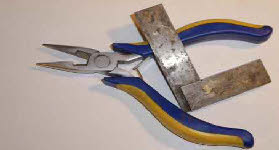

Tweakers
I’ve found that even with a great deal of care in fitting, the AJ can end up slightly too high or low, or not quite centred horizontally. One solution is to refit the jig to the vehicle, un-solder the AJ and reposition it slightly - and keep trying until it’s in the right place. As an alternative I’ve made a pair of adjusters - ‘tweakers’ - which can be used to make fine adjustments up, down or sideways.
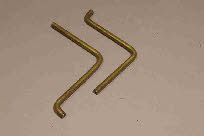 They are made from 1/16th inch brass wire, with saw cuts across the ends, just wide enough for the 11thou wire.
They are made from 1/16th inch brass wire, with saw cuts across the ends, just wide enough for the 11thou wire.
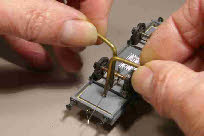
 The basic idea is that one of the pair can be used to hold the wire, and the other can be twisted to give a slight bend in the wire in the appropriate direction. Needless to say this is only for very fine adjustments -
The basic idea is that one of the pair can be used to hold the wire, and the other can be twisted to give a slight bend in the wire in the appropriate direction. Needless to say this is only for very fine adjustments - significant bends in the wire are likely to cause more problems. The photo on the left shows the AJ being adjusted vertically, and on the right, horizontally.
Armatures
I’ve tried various experiments wit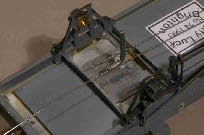 h different types of armatures (droppers), of different shapes, and using different starting materials. Nails work, but I think are visually intrusive. The ‘U’ shaped dropper didn’t seem to work at all, so I have finally opted for a simple upside-
h different types of armatures (droppers), of different shapes, and using different starting materials. Nails work, but I think are visually intrusive. The ‘U’ shaped dropper didn’t seem to work at all, so I have finally opted for a simple upside-down ‘L’ shaped dropper made from soft iron wire 1.2mm diameter - plant clips from a garden centre. I have tried thinner wire (less visible), but these seemed to lack pulling power, and didn’t pull down far enough to uncouple the vehicles over the electromagnets.
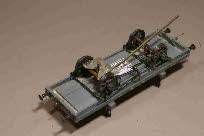 For fitting the armature I use another of the Turner jigs, but modified slightly with the addition of a short length of tube to hold the dropper vertical, as shown in the photo.
For fitting the armature I use another of the Turner jigs, but modified slightly with the addition of a short length of tube to hold the dropper vertical, as shown in the photo.
So, coupling made accurately, fitted and adjusted accurately, what could possibly go wrong? Well.........
Why don’t the AJ’s couple?
One of the first things I found out, is that the height of the couplings is absolutely crucial: if the couplings are not set to the correct height, then the vehicles simply will not couple, no matter what you try. There are no stated tolerances for height, as far as I know, but from experience I think +-0.5mm is about the maximum - and preferably less than this.
If the couplings aren’t quite central to the vehicle, then the couplings might work, or they might not. One of the things I discovered about my own wagons, (being very honest) is how poor some of the chassis alignment is - wheels not square to the wagon or centrally aligned with the buffers; too much side-slop in the W-irons; or buffers of slightly differing lengths. These are clearly not very desirable attributes in a vehicle, but equally may not be very noticeable, and may not cause too many problems in ordinary running.
However, they do give rise to problems with reliability of AJ’s. If there is too much side-slop in the W-irons, then the vehicle is unlikely to run square, especially when being pushed. The AJ therefore might or might not be central relative to the track (and hence the adjacent vehicle) and might or might not couple.
If the wheels and buffers are not centrally aligned with each other along the vehicle (and hence to the track and adjacent vehicles), then the fitting jig will not work - the AJ will align with the buffers, but not necessarily with the track centre-line, and hence will not couple.
A less obvious point relates to uneven buffer length. The fitting jig sets the AJ relative to the buffers, and to couple and uncouple reliably, 0.2mm clearance is required between the face of the buffers and the lower leg (tail) of the AJ. If the buffers are not the same length - say one is 0.2mm shorter than the other for example, then the fitting jig will set the AJ at an average of the buffer lengths. In the example quoted this would only give 0.1mm clearance when touching an adjacent vehicle, which is likely to cause difficulties. With sprung buffers, this may not affect coupling, but it can certainly affect uncoupling.
I’ve found that even with a great deal of care in fitting, the AJ can end up slightly too high or low, or not quite centred horizontally. One solution is to refit the jig to the vehicle, un-
 They are made from 1/16th inch brass wire, with saw cuts across the ends, just wide enough for the 11thou wire.
They are made from 1/16th inch brass wire, with saw cuts across the ends, just wide enough for the 11thou wire.
 The basic idea is that one of the pair can be used to hold the wire, and the other can be twisted to give a slight bend in the wire in the appropriate direction. Needless to say this is only for very fine adjustments -
The basic idea is that one of the pair can be used to hold the wire, and the other can be twisted to give a slight bend in the wire in the appropriate direction. Needless to say this is only for very fine adjustments -Armatures
I’ve tried various experiments wit
 h different types of armatures (droppers), of different shapes, and using different starting materials. Nails work, but I think are visually intrusive. The ‘U’ shaped dropper didn’t seem to work at all, so I have finally opted for a simple upside-
h different types of armatures (droppers), of different shapes, and using different starting materials. Nails work, but I think are visually intrusive. The ‘U’ shaped dropper didn’t seem to work at all, so I have finally opted for a simple upside- For fitting the armature I use another of the Turner jigs, but modified slightly with the addition of a short length of tube to hold the dropper vertical, as shown in the photo.
For fitting the armature I use another of the Turner jigs, but modified slightly with the addition of a short length of tube to hold the dropper vertical, as shown in the photo. So, coupling made accurately, fitted and adjusted accurately, what could possibly go wrong? Well.........
Why don’t the AJ’s couple?
One of the first things I found out, is that the height of the couplings is absolutely crucial: if the couplings are not set to the correct height, then the vehicles simply will not couple, no matter what you try. There are no stated tolerances for height, as far as I know, but from experience I think +-
If the couplings aren’t quite central to the vehicle, then the couplings might work, or they might not. One of the things I discovered about my own wagons, (being very honest) is how poor some of the chassis alignment is -
However, they do give rise to problems with reliability of AJ’s. If there is too much side-
If the wheels and buffers are not centrally aligned with each other along the vehicle (and hence to the track and adjacent vehicles), then the fitting jig will not work -
A less obvious point relates to uneven buffer length. The fitting jig sets the AJ relative to the buffers, and to couple and uncouple reliably, 0.2mm clearance is required between the face of the buffers and the lower leg (tail) of the AJ. If the buffers are not the same length -